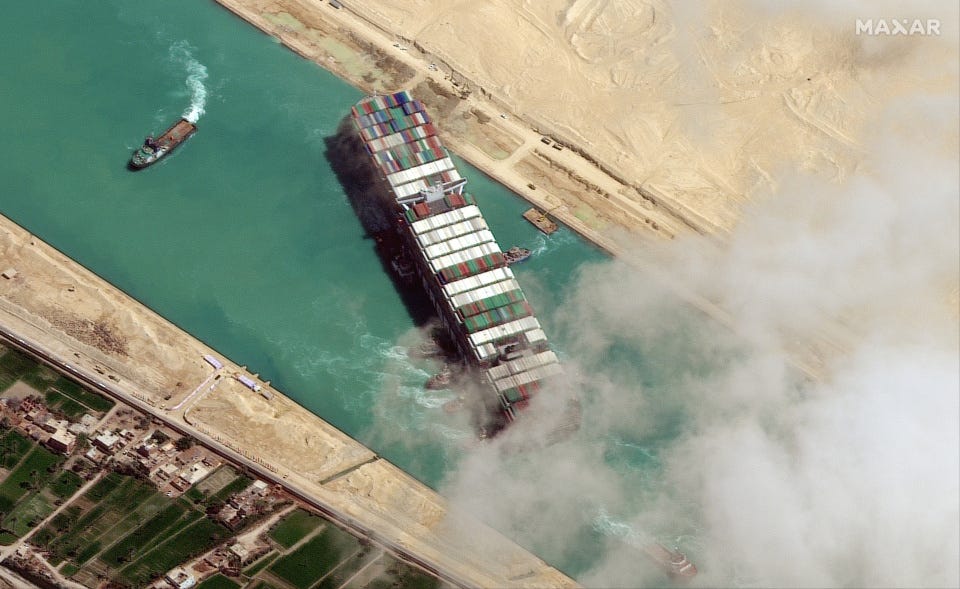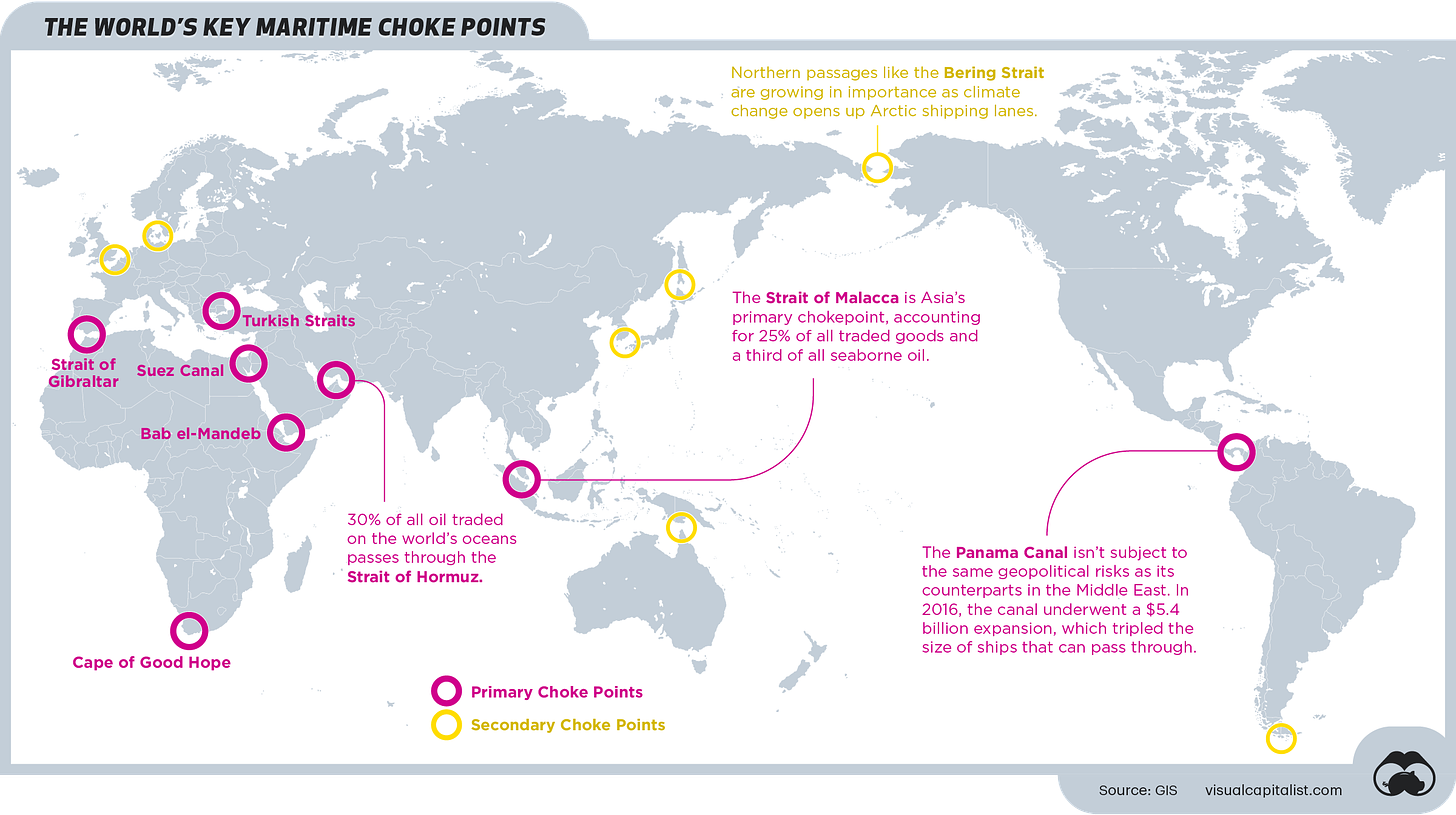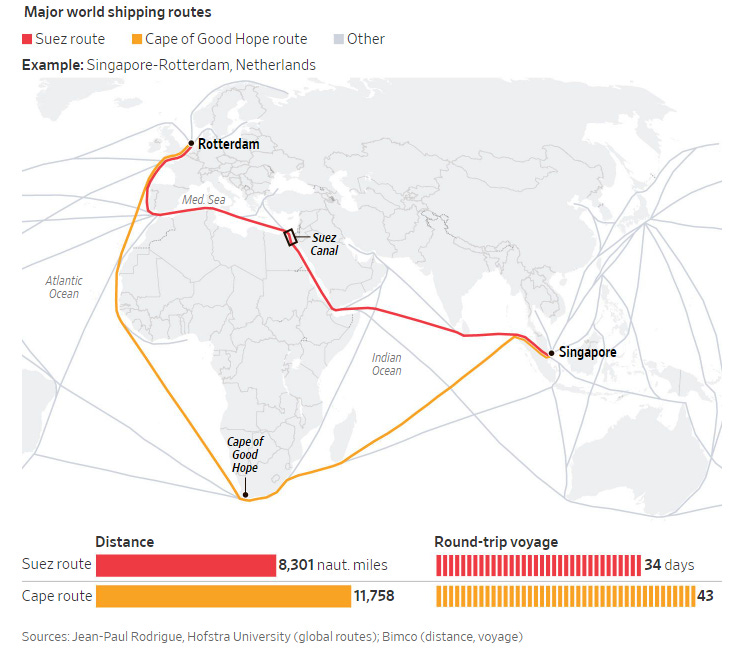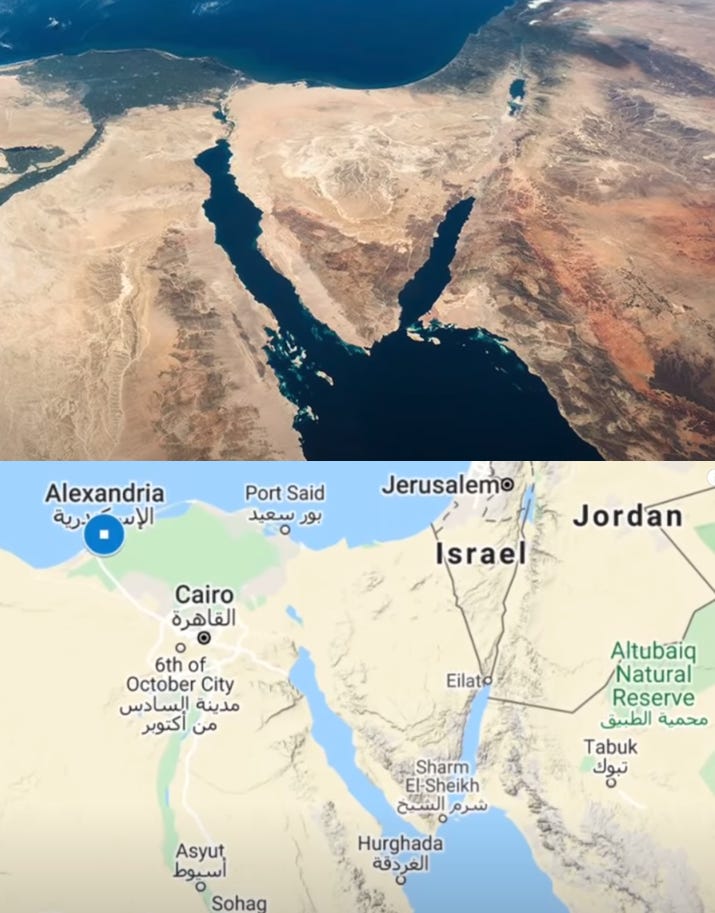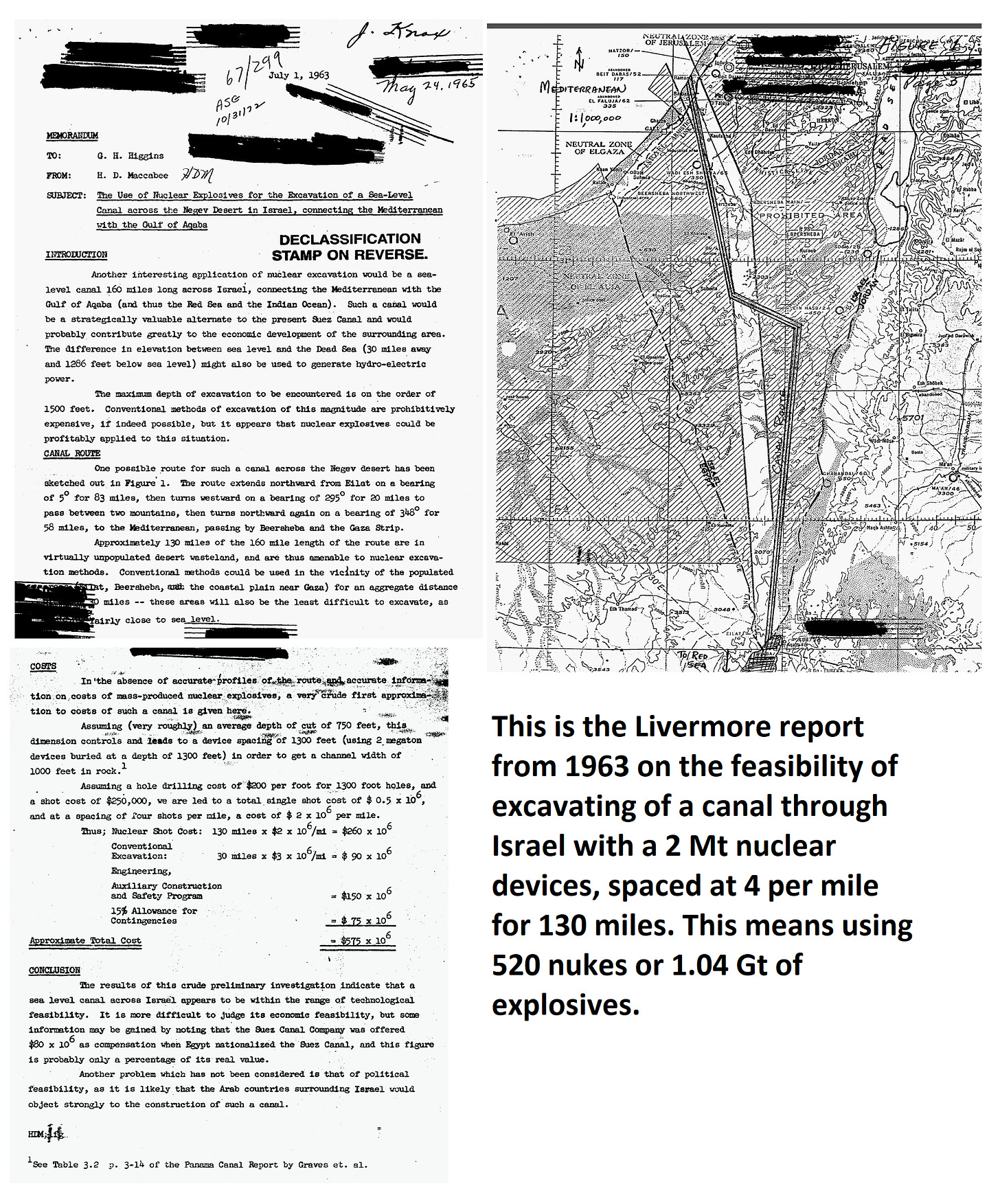Insightful newsletter of Drishtikone: Issue #275 - The Suez Blockade
Suez Canal was blocked for six days. In those six days, this blockage brought the world trade to its knees. What happened and why? What are the alternatives to this canal? Lets check.
Image by Angeline 1 from Pixabay
“Unexpected intrusions of beauty. This is what life is.” ― Saul Bellow, Herzog
We are all connected. Yet we are individuals. Complete and full in ourselves. Only when our needs grow larger than what our real requirements are - that unencumbered and sometimes unbridled trade becomes a norm. That is the state of the world today.
The pandemic and then the Suez Canal blockade in the last few weeks has taught us many lessons. What can we learn from them?
For now, let us understand what happened in the Suez and why. Also what are the future options that we have with us?
The Suez Blockade
A large container ship got stuck in Egypt's Suez Canal on March 23, halting marine traffic through one of the busiest waterways in the world. Ever Given, a Taiwanese ship, ran aground after strong winds and a sandstorm caused low visibility and poor navigation. One of the world's largest freight vessels, the Ever Given was bound for Europe's busiest port of Rotterdam prior to the mishap. The ship, at 400 meters, is almost as long as the Empire State Building is tall.
That should give us a sense of how big the ship was that caused the blockade of the Suez Canal. Now, Suez Canal is one of the eight primary “Maritime Choke Points.”
Why are these Maritime Choking Points critical for the world? Because roughly 80% of the global merchandise is sent via the sea. (Source)
Out of which, Suez Canal itself carries 12% of the global trade by volume! (Source)
Last year 19000 ships passed through the canal at an average of little over 51 a day. As of March 29, 350 ships were waiting on either side of the canal.
Nearly 19,000 ships passed through the canal during 2020, for an average of 51.5 per day, according to the Suez Canal Authority. More than 350 vessels are currently waiting on either side of the canal, according to estimates from Leth Agencies. This includes container ships, bulk carriers and oil tankers. (Source)
So, this blockade meant a backup of a huge amount of trade supplies which was disrupting the global trade. Each day of delay was causing a loss of $14-15 million! For Egypt, which gets 12% of its GDP via Suez, this was a major hit.
About 12% of global trade, around one million barrels of oil and roughly 8% of liquefied natural gas pass through the canal each day. SCA chairman Osama Rabie on Saturday that the Canal's revenues were taking a $14m-$15m (£10.2m-£10.9m) hit for each day of the blockage. Prior to the pandemic, trade passing through the Suez Canal contributed to 2% of Egypt's GDP, according to Moody's (Source)
The alternative route of going around the Cape of Good Hope adds a week to the schedule. That in itself is a big loss.
But why did the mishap happen? How did the ship get grounded in the middle of the Suez Canal?
Weather.
High Winds and an unusual dust storm caused the ship to be grounded. (Source)
Per New York Times, the winds had reached 70 mph.
From the outset, when winds of more than 70 miles per hour whipped up the sands surrounding the Suez Canal into a blinding storm and the Ever Given ran aground, the forces of nature have played an outsize role in the drama that has disrupted the free flow of goods and oil around the planet. (Source)
The statement from the company which operates the ship blamed the mishap on the weather.
Taiwan-based Evergreen Marine Corp., which was the ship’s operator, said in a statement, “This accident occurred at 6 nautical miles from the southern entry of the Canal as the container ship proceeded northbound through the waterway from the Red Sea. Gusting winds of 30 knots caused the container ship to deviate from its course, suspectedly leading to the grounding.” (Source)
HIgh speed winds that high are quite uncommon and it is not the first time that weather has impacted the ships in Suez Canal. At least twice - December 11, 2010, and February 11, 2015.
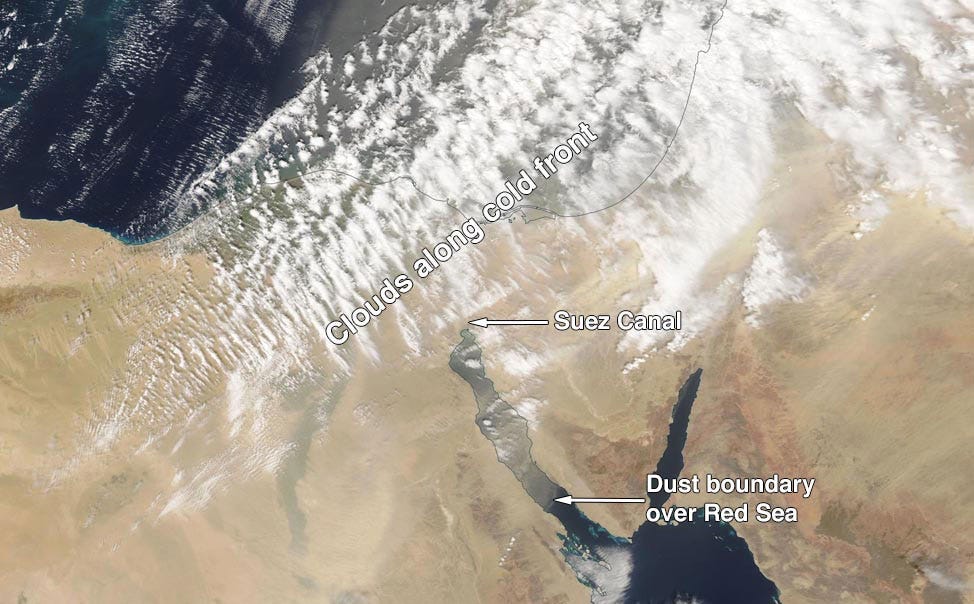
Once the ship was pushed by wind and dust, the water and wind dynamics took over.
As explained in an excellent analysis in the Financial Times (free registration required) by Brendan Greely, when a ship gets too close to a bank, shallow-water hydrodynamic forces can act to spin the boat – a well-known phenomenon known as the bank effect, where the water speeds up between the boat and the bank, the pressure drops, pulling the stern into the bank and pushing the bow away from shore. Possibly because of the bank effect, the Ever Given then slewed close to the opposite (east) bank of the canal. At that point, the vessel angled its heading to the left, perhaps again due to the bank effect, or possibly in response to a crosswind that had developed due to a wind shift to a more westerly direction. The ship again came close to the west (left) bank, potentially because of a swirling wind that briefly blew from the south, reducing the cross-wind component that was pushing the boat to the right. The Ever Given finally ran aground with its stern on the west bank of the canal and its bow on the east bank (Figure 3), suggesting that the bank effect may have acted to spin the ship and lodge it in the canal when it came too close to the west bank. (Source)
As the world weather changes and conflicts around the world sharpen, world trade can come to a halt that easily.
How does the world work-around this narrow strip of channel that was created artificially?
By creating another!
Suez Alternative
Look at the geography below. That entire triangle in the middle of two arms of the Red Sea gutting into the land is mostly Egypt and partly Israel on the right side. While the left side is the Suez Canal, Israel believes that they can have a channel on the right.
In 1963, a thinktank had thought about an alternative route that would dig up another canal via Israel. But at that time, there was a big question of “Political feasibility” due to Israel-Arab animosity.
The proposed route was through Israel’s Negev Desert which was listed as 130 miles of “virtually unpopulated desert wasteland, and are thus amenable to nuclear excavation methods” but there was always a glaring concern with this proposal which should be pretty obvious to anyone who is familiar with global politics. The report stated “political feasibility, as it is likely that the Arab countries surrounding Israel would strongly object to the construction of such a canal.” (Source)
Lawrence Livermore National Laboratory (LLNL) had published its findings on how to go about it.
The Livermore report was published on July 1, 1963 report and was declassified in 1996. You can download the report in its pdf format from here - Source. Alex Wellerstein share a part on Twitter (Source)
The method that Livermore report talked about was the hot subject of the 1960s interestingly called “Peaceful Nuclear Explosives.”
The memo came as the US Atomic Energy Commission was investigating using "peaceful nuclear explosions" (PNEs) to dig out useful infrastructure, Forbes reported in 2018. There were also plans to use this method to dig out a canal in Central America, Forbes reported. (Source)
The oxymoronic concept of Peaceful Nuclear Explosives was developed by the Lawrence Livermore National Laboratory (LLNL) in the late 1950s.
As outlandish as this idea may seem, the US and USSR did carry out 151 experiments (USSR 124 and US did 27) using this explosive technique.
In total, 151 “experiments” were carried out in total, by both sides, from 1957-1975 for the US and 1965-1989 for the USSR. The tests had multiple purposes, from excavating fossil fuels and creating spaces for future mining to burning out gas field fires and – yes – creating reservoirs, ports, and canals (Source)
Lake Chagan in Kazakhastan was probably the only real use of the PNE idea.
The first to move forward would instead be the United States’ Project Plowshare proposed to the UN in 1958, to detonate its first PNE blast ‘Project Gnome’ on December 10, 1961. The Soviets waited until 1965 to launch PENE; the Chagan is often times categorized under this umbrella program, but in fact there were two categories to separate developmental intentions. Program 7, or “Peaceful Nuclear Explosions for the National Economy” (PNENE) sought to find useful mineral resources with reflection seismology properties; this would be useful to later extract oil and gas. Program 6, titled “Employment of Nuclear Explosive Technologies in the Interests of National Economy” was purposed for developing underground toxic waste storage, dams and canals, and bodies of water. Thus technically, Lake Chagan was created via Program 6, acting as one of four channel and dam explosions performed throughout Program 6. September 6th, 1988 marked the last detonation of all of this program, an explorative geological explosion nicknamed Rubin-1. (Source)
That over 60-year-old technique may be dusted and brought out to be used again. (Source)
Meanwhile, some creative folks have another explanation for what happened.
And, the curse?
The Egyptian authorities plan to transport 22 royal mummies including those of King Ramesses II, Seqenenre Tao, Thutmose III, and Seti I, and Queen Hatshepsut from a museum in Tahrir Square to a new permeant display at the National Museum of Egyptian Civilisation in a parade on April 3rd. Ramesses II - who was also known as Ramesses the Great - ruled from 1279 to 1213 BC and has been regarded as the most powerful pharaoh. Apparently, the guy’s mummy carried a curse with it.
So the Twitter world is ablaze with conspiracy theories of the curse of Ramesses.
And it gained more currency because of the collapse of an apartment building (Source) and a collision between two trains that killed 32 people (Source).
So, weather or the mummies - or the living with weapons and war on the mind - something or someone is bound to bring the global trade to a halt with something as innocuous as a titled ship run aground.
What options do we have?
Will this be treated as a warning to reduce globalization and reduce dependence on exports for your critical products? Specifically food?
market corner: 10 quick bytes
World Bank raises India's FY22 GDP forecast to 10.1% from 5.4% earlier - more
Data of 10 crore fintech company Mobikwik users for sale on the dark web, say cybersecurity experts - more
InMobi, India’s 1st unicorn, plans US IPO at the value of up to $15 billion - more
GST e-invoicing welcome step for midsize firms but might be a challenge for micro, small units: FISME - more
China’s mega-refineries are throttling other Asia oil processors - more
Samsung TV Plus “100% free” OTT streaming service launched in India: Eligibility, content partners and everything to know - more
Govt approves Rs 10,900 crore PLI scheme for food processing sector - more
PAN-Aadhaar Linking Last Date: Your last chance to link them online and avoid getting PAN inoperative - more
Programming with Python most-learned tech skill in the span of five years: Report - more
Australia to build guided missiles to boost defense capacity - more
nota bene
Court reprimands Police Commissioner: "You (Singh) are a senior police officer. You are not a layman. You were duty-bound to register a complaint against any wrongdoing. Despite knowing that an offense is being committed by your boss, you (Singh) remained silent," Chief Justice Datta said. The HC was hearing criminal public interest litigation (PIL) filed in the HC on March 25 by Singh, seeking a CBI probe against Deshmukh.
The bench further noted that Singh cannot convert the HC into a magistrate court. "The proper and appropriate course of action would be for you (Singh) to first lodge a complaint with police. If the police do not lodge an FIR, then you have the option of filing an application before the magistrate," the court said.
Singh's counsel Vikram Nankani said his client wanted to avoid this "chakravyuh" (labyrinth). The HC, however, noted this was the procedure laid down in law.
"Are you saying that you are above the law?" Chief Justice Datta asked. (Source)
Mamata to lose Nandigram?: Hours before West Bengal goes to vote in phase 2 of phase state assembly elections, a purported image of IPAC’s internal survey has gone viral on social media which predicts Mamata Banerjee losing the Nandigram seat. IPAC is the agency run by poll strategist Prashant Kishor who is hired by the West Bengal Chief Minister for the ongoing polls. The leaked image, which shows a survey of the 30 seats which go to polls in phase 2 suggests a huge surge for the BJP. The survey predicts 23 out of 30 seats for BJP while TMC will be reduced to just 5 seats. (Source)
Halal and Jhatka: North MCD mayor said the 'restaurants must mention meat is halal or jhatka'. " In Hinduism & Sikhism, 'halal' meat is prohibited. So we approved a proposal, making it mandatory for all restaurants, dhabas & meat shops in North Delhi Municipal Corporation to put up posters stating whether they serve/sell 'halal' or 'jhatka' meat," Mayor Jai Prakash said. (Source)
Self-Healing Robots: Stem cells from frog embryos have been transformed into self-healing robots, capable of having memories to recall events that will help researchers make further analyses. The ability to recall events will help the cell-bots remember contamination, chemical pollutants or a disease condition in the body. This innovation is an upgraded version of the Xenobots announced last year, but are faster, smarter and have a longer lifespan. (Source)
AI Script Writer: The next blockbuster to grace cinema screens after lockdown could be written by a computer, according to the authors of a new study examining movie tropes. They discovered that big movies tend to stick to the same core tropes, with clusters of storytelling devices appearing repeatedly in the biggest films every year. Researchers from the University of Granada and the University of Cádiz looked for common tropes in more than 10,000 movies, their ratings, genre, and reviews. (Source)
video corner: Free Hindu Temples
A few issues back we had written about the history of the government’s control and desecration of the temples and why they need to be freed from this unacceptable encroachment of one religious community’s right! Please read - Issue #267 - Free the Temples!
Now the movement by Sadhguru has picked up speed. Seekers and meditators from all over Tamil Nadu are going around the state and taking footage of temples that have been desecrated and dilapidated. Some of these temples have been very powerful spaces. Some still are! Check out the tweets in the links below.
Muktheeshwarar Temple, Samayapuram, temple in pullukudi village near Ramanathapuram, Airavatheeshwarar temple, Nageswaramudaiyar Temple, Korakkar Siddhar Temple
Please watch this interview of Sadhguru to understand the pain and destruction that has been wrought upon the most powerful spiritual tradition in the world. And although many folks have worked to free the Hindu temples, the difference that Sadhguru brings is - he works to get results. At the end of this movement, you wont see many reports or seminars or books - you will see Free Temples.
Today’s ONLINE PAPER: Check out today’s “The Drishtikone Daily” edition. - THE DRISHTIKONE DAILY
Nuzzle Tweets “newsletter” - with tweets and stories that we read and follow in a day in one compilation on a daily basis - Nuzzle Drishtikone - just another way to keep up with things
SUPPORT DRISHTIKONE: If you consider our work important and enriching and would like to contribute to our expenses, please click on the button below to go to the page to send in your contribution. You can select the currency (for example, INR or USD, etc) and the amount you would like to contribute. Contribute to Drishtikone
If you like this post - please share it with someone who will appreciate the information shared in this edition
If you like our newsletter, please share it with your friends and family





